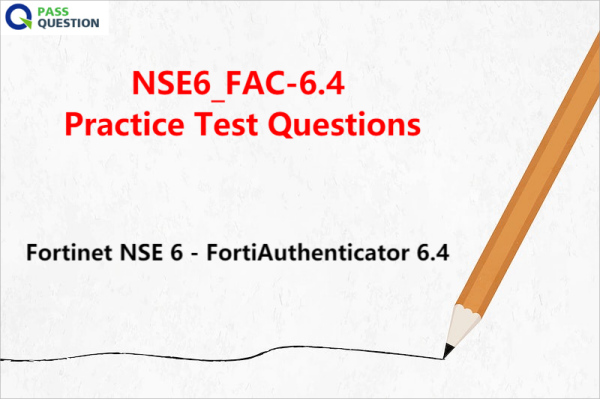NSE6_FAC-6.4 Practice Test Questions - Fortinet NSE 6 - FortiAuthenticator 6.4
PassQuestion has recently launched its NSE6_FAC-6.4 Practice Test Questions, which are specifically designed to assist individuals in successfully passing the Fortinet NSE 6 - FortiAuthenticator 6.4 exam. This comprehensive collection of practice questions is a valuable resource for candidates seeking to enhance their knowledge and skills in FortiAuthenticator devices. By engaging with these NSE6_FAC-6.4 Practice Test Questions, candidates can assess their understanding of these concepts and identify any knowledge gaps that need to be addressed prior to taking the actual exam. With PassQuestion NSE6_FAC-6.4 Practice Test Questions, candidates can optimize their exam preparation and increase their chances of achieving a successful outcome in the Fortinet NSE 6 - FortiAuthenticator 6.4 exam.

Fortinet NSE 6 - FortiAuthenticator 6.4
The Fortinet NSE 6 - FortiAuthenticator 6.4 exam is designed for professionals in the field of network and security. It is a component of the NSE 6 Network Security Specialist program and assesses the candidate's proficiency in working with FortiAuthenticator devices. The exam evaluates practical knowledge related to the configuration, operation, and daily management of FortiAuthenticator systems. It covers areas such as user administration, PKI certificates, configuration extracts, and troubleshooting captures. This certification is particularly relevant for individuals who are responsible for configuring and managing endpoint security solutions within an enterprise network security infrastructure.
Exam Information
Exam name: Fortinet NSE 6 - FortiAuthenticator 6.4
Exam series: NSE6_FAC-6.4
Time allowed: 60 minutes
Exam questions: 30 multiple-choice questions
Scoring Pass or fail. A score report is available from your Pearson VUE account.
Language: English
Product version: FortiAuthenticator 6.4
Exam Objectives
Successful candidates have applied knowledge and skills in the following areas and tasks:
FortiAuthenticator management
- Configure FortiAuthenticator for deployment
- Understand and configure administrative accounts and roles
- Configure advanced system settings
- Configure and manage user accounts
Certificate management
- Describe key concepts of PKI and digital certificates
- Use the FortiAuthenticator certificate management service to generate local certificates
- Implement automatic certificate management services
Active authentication
- Implement RADIUS profiles and realms for RADIUS authentication
- Configure and manage supported remote authentication services
- Use FortiAuthenticator portal services to authenticate local and remote users
- Configure tokens and two-factor authentication
Single sign-on
- Integrate FortiAuthenticator with Active Directory (AD) to detect logon events
- Use local authentication events for Fortinet Single Sign-On (FSSO)
- Use third-party logon events via RADIUS single sign-on (RSSO), tags, and logs to generate FSSO events
- Implement SAML roles on FortiAuthenticator for the SAML SSO service
View Online Fortinet NSE 6 - FortiAuthenticator 6.4 NSE6_FAC-6.4 Free Questions
1. When you are setting up two FortiAuthenticator devices in active-passive HA, which HA role must you select on the master FortiAuthenticator?
A.Active-passive master
B.Standalone master
C.Cluster member
D.Load balancing master
Answer: A
2. Which statement about the guest portal policies is true?
A.Guest portal policies apply only to authentication requests coming from unknown RADIUS clients
B.Guest portal policies can be used only for BYODs
C.Conditions in the policy apply only to guest wireless users
D.All conditions in the policy must match before a user is presented with the guest portal
Answer: D
3. Which two capabilities does FortiAuthenticator offer when acting as a self-signed or local CA? (Choose two)
A.Validating other CA CRLs using OSCP
B.Importing other CA certificates and CRLs
C.Merging local and remote CRLs using SCEP
D.Creating, signing, and revoking of X.509 certificates
Answer: B, D
4. Which three of the following can be used as SSO sources? (Choose three)
A.FortiClient SSO Mobility Agent
B.SSH Sessions
C.FortiAuthenticator in SAML SP role
D.Fortigate
E.RADIUS accounting
Answer: A, D, E
5. You are the administrator of a large network that includes a large local user datadabase on the current Fortiauthenticatior. You want to import all the local users into a new Fortiauthenticator device.
Which method should you use to migrate the local users?
A.Import users using RADIUS accounting updates.
B.Import the current directory structure.
C.Import users from RADUIS.
D.Import users using a CSV file.
Answer: D
6. Which two SAML roles can Fortiauthenticator be configured as? (Choose two)
A.Idendity provider
B.Principal
C.Assertion server
D.Service provider
Answer: A, D
- TOP 50 Exam Questions
-
Exam
All copyrights reserved 2025 PassQuestion NETWORK CO.,LIMITED. All Rights Reserved.

